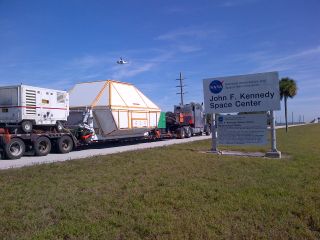Welcome Home, Orion! NASA Space Capsule Back in Florida After Test Flight

NASA's first Orion space capsule — which made its spaceflight debut at the beginning of this month — has returned to Florida after more than a week in transit.
The capsule, designed to bring humans farther into space than ever before, flew to space for its first unmanned test flight on Dec. 5 from Kennedy Space Center in Florida. The spacecraft then splashed down in the Pacific Ocean about 4.5 hours later, when the U.S. Navy retrieved it and towed it into port in San Diego. Orion then went on a cross-country road trip that ultimately brought it back to Kennedy Space Center today (Dec. 18).
Orion's test flight was designed to be rigorous, stressing many of its systems that could one day be used for crewed missions to deep-space destinations like Mars. NASA officials want to examine the flown capsule to see exactly how it stood up to the extreme space environment during its launch, two orbits of Earth, re-entry and splashdown. [Orion's 1st Test Flight: Complete Coverage]

"The flight itself was such a great success, but that's only the beginning of the story," Orion Program Manager Mark Geyer said in a statement. "Now, we get to dig in and really find out if our design performed like we thought it would. This is why we flew the flight. We demonstrated on Dec. 5 that Orion is a very capable vehicle. Now, we're going to keep testing and improving as we begin building the next Orion."
Orion's test earlier this month marked the first time a spacecraft built for humans has flown beyond low-Earth orbit in more than 40 years. The spacecraft is also the first capsule built by NASA designed to take humans to Mars. Space agency officials hope that, one day, Orion could be part of a system that takes astronauts to and from the Red Planet or other destinations like an asteroid.
The capsule flew about 3,600 miles (5,800 kilometers) above Earth's surface during its highest point in orbit. It then started plummeting back to Earth. The spacecraft's huge heat shield seemed to stand up to the extreme heat produced when the capsule came back through the planet's atmosphere, and its parachutes seemed to function well, NASA scientists said.
"Orion's flight test was a critical step on our journey to send astronauts to explore deep-space destinations," Bill Hill, NASA's deputy associate administrator for exploration systems development, said in the same statement. "We stressed Orion to help us evaluate its performance and validate our computer models and ground-based evaluations, and the information we gathered will help us improve Orion's design going forward."
Get the Space.com Newsletter
Breaking space news, the latest updates on rocket launches, skywatching events and more!
Follow Miriam Kramer @mirikramer. Follow us @Spacedotcom, Facebook and Google+. Original article on Space.com.
Join our Space Forums to keep talking space on the latest missions, night sky and more! And if you have a news tip, correction or comment, let us know at: community@space.com.

Miriam Kramer joined Space.com as a Staff Writer in December 2012. Since then, she has floated in weightlessness on a zero-gravity flight, felt the pull of 4-Gs in a trainer aircraft and watched rockets soar into space from Florida and Virginia. She also served as Space.com's lead space entertainment reporter, and enjoys all aspects of space news, astronomy and commercial spaceflight. Miriam has also presented space stories during live interviews with Fox News and other TV and radio outlets. She originally hails from Knoxville, Tennessee where she and her family would take trips to dark spots on the outskirts of town to watch meteor showers every year. She loves to travel and one day hopes to see the northern lights in person. Miriam is currently a space reporter with Axios, writing the Axios Space newsletter. You can follow Miriam on Twitter.
